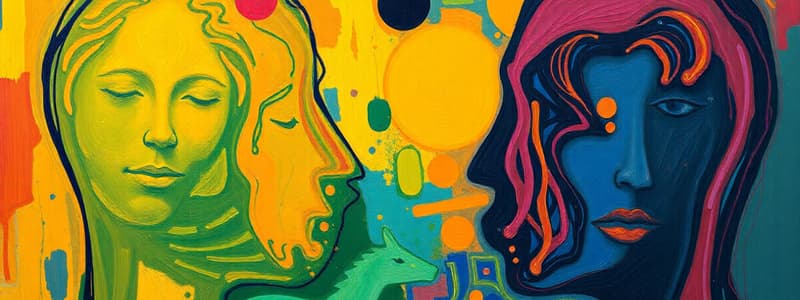Podcast
Questions and Answers
Which of the following is NOT a criterion for diagnosing bipolar II disorder?
Which of the following is NOT a criterion for diagnosing bipolar II disorder?
- Symptoms not explained by a psychotic disorder
- At least one hypomanic episode
- At least one major depressive episode
- At least one manic episode (correct)
What is the primary distinction between bipolar I and bipolar II disorders?
What is the primary distinction between bipolar I and bipolar II disorders?
- Bipolar II does not cause clinically significant distress
- Full-blown mania is absent in bipolar II (correct)
- Presence of mixed features in bipolar II
- Bipolar II features more severe depressive episodes
Which severity classification indicates the least impairment in functioning?
Which severity classification indicates the least impairment in functioning?
- Severe
- Moderate
- Critical
- Mild (correct)
What is a key characteristic of a manic episode in bipolar disorder?
What is a key characteristic of a manic episode in bipolar disorder?
Which of the following specifies an episode currently deemed as hypomanic?
Which of the following specifies an episode currently deemed as hypomanic?
Which of the following is NOT a type of bipolar disorder according to DSM-5?
Which of the following is NOT a type of bipolar disorder according to DSM-5?
Which of the following is one of the specifiers that must be identified when diagnosing bipolar disorder?
Which of the following is one of the specifiers that must be identified when diagnosing bipolar disorder?
What is the minimum duration required for a manic episode to be diagnosed?
What is the minimum duration required for a manic episode to be diagnosed?
What characterizes cyclothymic disorder?
What characterizes cyclothymic disorder?
In bipolar II disorder, the term 'rapid cycling' refers to:
In bipolar II disorder, the term 'rapid cycling' refers to:
During which ages is bipolar disorder most commonly diagnosed?
During which ages is bipolar disorder most commonly diagnosed?
Which of the following best describes bipolar II disorder?
Which of the following best describes bipolar II disorder?
Which symptom is not classified as a mood specifier in bipolar disorder?
Which symptom is not classified as a mood specifier in bipolar disorder?
What effect can untreated bipolar disorders have on a person's life?
What effect can untreated bipolar disorders have on a person's life?
What distinguishes a hypomanic episode from a manic episode?
What distinguishes a hypomanic episode from a manic episode?
Which of the following symptoms is typically seen in a hypomanic episode?
Which of the following symptoms is typically seen in a hypomanic episode?
What is the minimum number of symptoms required to diagnose a manic episode when the mood is irritable?
What is the minimum number of symptoms required to diagnose a manic episode when the mood is irritable?
Which of the following is NOT a symptom associated with manic episodes in bipolar I disorder?
Which of the following is NOT a symptom associated with manic episodes in bipolar I disorder?
Which statement best describes the requirement for the severity of a manic episode in bipolar I disorder?
Which statement best describes the requirement for the severity of a manic episode in bipolar I disorder?
What is the defining characteristic of bipolar I disorder compared to other mood disorders?
What is the defining characteristic of bipolar I disorder compared to other mood disorders?
In between episodes of mania and depression, individuals with bipolar I disorder may:
In between episodes of mania and depression, individuals with bipolar I disorder may:
What distinguishes bipolar I disorder from bipolar II disorder?
What distinguishes bipolar I disorder from bipolar II disorder?
For a diagnosis of a manic episode, the change in functioning must be:
For a diagnosis of a manic episode, the change in functioning must be:
Which of the following symptoms indicates a potential manic episode when accompanied by increased energy and activity?
Which of the following symptoms indicates a potential manic episode when accompanied by increased energy and activity?
Flashcards
Manic Episode Symptoms
Manic Episode Symptoms
At least 3 symptoms of increased energy, activity, and mood disturbance (4 if mood is irritable). These include inflated self-esteem, decreased need for sleep, increased talkativeness, racing thoughts, distractibility, increased activity, and risky behaviors.
Bipolar I Disorder Criteria A
Bipolar I Disorder Criteria A
Meeting criteria for at least one manic episode in a person's life.
Bipolar I Disorder Functioning
Bipolar I Disorder Functioning
The change in functioning during a manic episode must be noticeable to others, and the individual may be able to function normally in between episodes.
Mania and Depression
Mania and Depression
Signup and view all the flashcards
Psychotic Features in Mania
Psychotic Features in Mania
Signup and view all the flashcards
Substance-Induced Mania
Substance-Induced Mania
Signup and view all the flashcards
Manic Episode's Effect on Life
Manic Episode's Effect on Life
Signup and view all the flashcards
Bipolar I Disorder - Normal Life
Bipolar I Disorder - Normal Life
Signup and view all the flashcards
Bipolar Disorders
Bipolar Disorders
Signup and view all the flashcards
Manic Episode
Manic Episode
Signup and view all the flashcards
Bipolar I Disorder
Bipolar I Disorder
Signup and view all the flashcards
Bipolar II Disorder
Bipolar II Disorder
Signup and view all the flashcards
Cyclothymic Disorder
Cyclothymic Disorder
Signup and view all the flashcards
Hypomanic Episode
Hypomanic Episode
Signup and view all the flashcards
Depressive Episode
Depressive Episode
Signup and view all the flashcards
Diagnostic Criteria (Manic Episode)
Diagnostic Criteria (Manic Episode)
Signup and view all the flashcards
Major Depressive Episode
Major Depressive Episode
Signup and view all the flashcards
Bipolar Disorder Severity
Bipolar Disorder Severity
Signup and view all the flashcards
Bipolar Disorder Specifiers
Bipolar Disorder Specifiers
Signup and view all the flashcards
Diagnostic Criteria for Bipolar II
Diagnostic Criteria for Bipolar II
Signup and view all the flashcards
Episode Specifiers for Bipolar II
Episode Specifiers for Bipolar II
Signup and view all the flashcards
Study Notes
Bipolar and Related Disorders
- Bipolar disorders are a group of conditions causing extreme mood fluctuations, impacting energy and functioning.
- Previously known as manic-depressive disorder, DSM-5 classifies them as bipolar and related disorders.
- Bipolar disorder encompasses three types: Bipolar I disorder, Bipolar II disorder, and Cyclothymic disorder.
- Untreated disorders adversely affect relationships, career prospects, and academic performance. Suicide risk is also a concern.
- Diagnosis typically occurs between the ages of 15 and 25, but can happen at any age.
- Bipolar disorders affect males and females equally.
- Three key episode types include: Manic Episodes, Hypomanic Episodes, and Depressive Episodes.
Manic Episode
- Mania is the opposite pole of depression.
- A manic episode isn't a disorder itself but a component of bipolar disorder.
- Individuals in a manic state experience dramatic and inappropriate mood swings. Symptoms impact emotional, motivational, behavioral, and cognitive functioning.
Distinctive Features of Mania
- Manic episodes can be preceded or followed by hypomanic or major depressive episodes.
- Characterized by a distinct period of abnormally elevated, expansive, or irritable mood.
- Abnormally and persistently increased activity or energy levels.
Topic 71: Diagnostic Criteria of Manic Episode
- DSM-5 criteria for a manic episode require a distinct period (at least 1 week) of elevated mood, expansive mood, or irritability, lasting most of the day.
- At least three indicative symptoms (four if mood is only irritable) must be present to a significant degree. These include: inflated self-esteem or grandiosity, reduced need for sleep, increased talkativeness, racing thoughts, distractibility, increased goal-directed activity (socially, work, or school), or excessive involvement in activities with high potential for painful consequences.
Topic 72: Hypomanic Episode
- Hypomania is a less extreme form of mania, not typically causing significant impairment.
- Characterized by a change in functioning, typically resulting in increased sociability, flirtatiousness, energy, and productivity.
Topic 73: Bipolar I Disorder
- Bipolar I disorder involves at least one manic episode.
- A person with bipolar 1 disorder may experience both manic and depressive episodes.
- Diagnostic criteria require meeting at least one manic episode criterion.
Topic 74: Bipolar II Disorder
- Bipolar II disorder is characterized by cycles of depressive episodes and hypomanic episodes.
- Elevated moods do not escalate to full-blown mania as in Bipolar I.
- Diagnostic criteria include at least one hypomanic episode and one major depressive episode; no manic episodes.
Topic 75: Cyclothymic Disorder
- Chronic, fluctuating mood swings with periods of hypomanic and depressive symptoms.
- The symptoms must be present for at least two years (one in children/adolescents).
- Neither episode meets the duration criterion for hypomania or major depressive episodes.
Topic 76: Substance/Medication Induced Bipolar Disorder
- This disorder results from substance use or withdrawal, with symptoms developing during or soon after substance use or withdrawal.
- Symptoms can include elevated, expansive, or irritable mood, or markedly diminished interest or pleasure.
- The disorder is not better explained by other bipolar disorders or by an independent non-substance/medication-induced bipolar disorder.
Studying That Suits You
Use AI to generate personalized quizzes and flashcards to suit your learning preferences.




